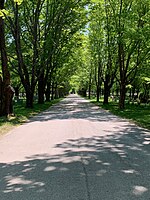Ledge Cemetery

Ledge Cemetery, also known as the Cemetery under the Ledge, is a historic cemetery in Yarmouth, Maine, United States. Dating to 1770, it stands on Gilman Road, around 450 feet (140 m) southwest of the older and smaller Pioneer Cemetery. Some headstones bear dates earlier than 1770, for many burials — such as that of Revd. Nicholas Loring — were removed from the older cemeteryThe original First Parish Congregational Church, known as the Old Ledge Meetinghouse, stood near the site between 1730 and 1818. Its first pastor was Reverend Ammi Ruhamah Cutter. Tristram Gilman, for whom Gilman Road is named, was the fourth pastor. He served in the role for forty years, and was buried in the Ledge Cemetery upon his death in 1809, aged 73. His wife, Elizabeth Sayer, is buried beside him.Several sea captains are also interred here, including those from the Drinkwater family. Captain Theophilus Drinkwater, son of Allen and Hannah Drinkwater, gave his name to nearby Drinkwater Point Road.Of a settlement that originally contained a school, a tavern and a cemetery, only the cemetery and the ledge doorstep of the church remain.
Excerpt from the Wikipedia article Ledge Cemetery (License: CC BY-SA 3.0, Authors, Images).Ledge Cemetery
Gilman Road,
Geographical coordinates (GPS) Address Nearby Places Show on map
Geographical coordinates (GPS)
| Latitude | Longitude |
|---|---|
| N 43.7847 ° | E -70.1757 ° |
Address
Gilman Road 23
04096
Maine, United States
Open on Google Maps









